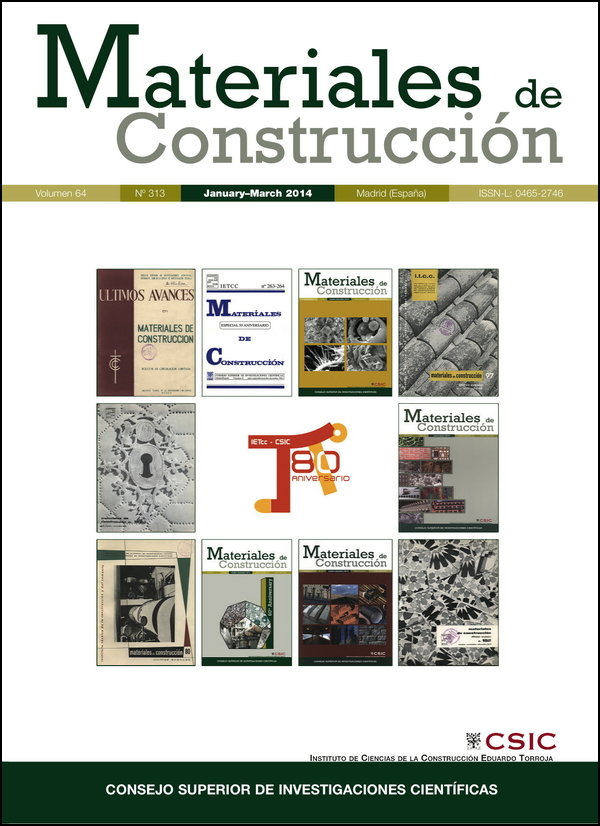Experimental study of masonry wall exposed to blast loading
DOI:
https://doi.org/10.3989/mc.2014.01513Keywords:
Brick, Acceleration, Deformation, Compressive strengthAbstract
The challenge of protecting the nation against the attack of terrorism has raised the importance to explore the understanding of building materials against the explosion. Unlike most of the building materials, brick masonry materials offer relatively small resistance against blast loading. In this research, a brick masonry wall was exposed to varying blast load at different scaled distances. Six tests with different amounts of explosives at various distances were carried out. Pressure time history, acceleration time history and strain at specific location were measured. The parameters measured from experimental pressure time history and acceleration time history is compared with those determined by ConWep to establish the correlations between experimental determined records and ConWep values. The experimental results were also compared with some researchers. These correlations may assist in understanding the behaviour of masonry structures subjected to explosive loading.
Downloads
References
1. Fischer, K.; Riedel, W.; Ziehm, J. (2011) Full-scale validation of a blast-proof masonry wall system and assessment of coupling effects using a TDOF model. 14th International Symposium on Interaction of the Effects of Munitions with Structures- ISIEMS.
2. Ehsani, M.R.; Saadatmanesh H.; Velazquez-Dimas, J.I. (1999) Behavior of retrofitted URM walls under simulated earthquake loading. J. Compos. Constr, 3 [3], 134–142. http://dx.doi.org/10.1061/(ASCE)1090-0268(1999)3:3(134)
3. Varma, R.K.; Tomar, C.P.S.; Parkash, S.; Sethi, V.S. (1996) Damage to brick masonry panel walls under high explosive detonations. ASME-Publications-PVP, 351, 207–216.
4. Casadei, P.; Agneloni, E. (2010) Elastic systems for dynamic retrofitting (ESDR) of structures. 1st International Conference of Protective Structures (ICPS), Manchester, UK.
5. Ward, S.P. (2008) Retrofitting walls to resist blast loads. 20th International Symposium on Military Aspects of Blast and Shock, Oslo, Norway.
6. Wei, X.Y.; Huang, T.; Li, N. (2012) Numerical Derivation of Pressure-Impulse Diagrams for Unreinforced Brick Masonry Walls. Adv Mater Res Zug, 368/373, 1435–1439, 4th International conference Technology of architecture and structure.
7. Wu, C.; Hao, H. (2007) Numerical simulation of structural response and damage to simultaneous ground shock and air blast loads. Int j impact eng, 34 [3], 556–572. http://dx.doi.org/10.1016/j.ijimpeng.2005.11.003
8. Godinho, J.; Agnew, E.I.; Marjanishvilli, S. (2007) Resistance of Historic Unreinforced Masonry Walls to Air-Blast Loads. SO: Structure, 20–22.
9. Ngo, T.; Mendis, P.; Gupta, A.; Ramsay, J. (2007) Blast loading and blast effects on structures, An overview. Electron J Struct Eng, 7, 76–91.
10. Urgessa, G.S.; Maji, A.K. (2009) Dynamic Response of Retrofitted Masonry Walls for Blast Loading. J Eng Mech, 136 [7], 858–864. http://dx.doi.org/10.1061/(ASCE)EM.1943-7889.0000128
11. Wei, X.; Stewart, M.G. (2010) Model validation and parametric study on the blast response of unreinforced brick masonry walls. Int J Impact Eng, 37 [11], 1150–1159. http://dx.doi.org/10.1016/j.ijimpeng.2010.04.003
12. Sorensen, A.; McGill, W.L. (2011) What to look for in the aftermath of an explosion? A review of blast scene damage observables. Eng Fail Anal, 18 [3], 836–845. http://dx.doi.org/10.1016/j.engfailanal.2010.12.010
13. Brode, H.L. (1955) Numerical solutions of spherical blast waves. J Appl Phys, 26 [6], 766–775. http://dx.doi.org/10.1063/1.1722085
14. Henrych, J.; Major, R. (1979) The dynamics of explosion and its use. Elsevier scientific publishing company, New York.
15. Smith, P.D.; Hetherington, J.G. (1994) Blast and ballistic loading of structures. Butterworth-Heinemann Oxford, UK.
16. Formby, S.A.; Wharton, R.K. (1996) Blast characteristics and TNT equivalence values for some commercial explosives detonated at ground level, J Hazard Mater, 50 [2], 183–198. http://dx.doi.org/10.1016/0304-3894(96)01791-8
17. ConWep: Conventional weapons Effects Program. (2005) Version 2.1.0.8 U.S. Army Vicksburg, MS USA.
18. UFC: Structures to Resist the Effects of Accidental Explosions. (2008) Unified Facilities Criteria (UFC) 3-340–02.
19. AASTP: Manual of NATO Safety Principles for the Storage of Military Ammunition and Explosives, (2010). Edition 1, Change 3, Allied Ammunition Storage and Transport Publication.
20. Brode, H.L. (1959) Blast wave from a spherical charge. Physics of fluids, 2 [2], 217–229. http://dx.doi.org/10.1063/1.1705911
21. Brode, H.L. (1968) Review of nuclear weapons effects. Annual review of nuclear science, 18 [1], 153–202. http://dx.doi.org/10.1146/annurev.ns.18.120168.001101
22. Wu, C.; Hao, H. (2005) Modeling of simultaneous ground shock and airblast pressure on nearby structures from surface explosions. International journal of impact engineering, 31 [6], 699–717. http://dx.doi.org/10.1016/j.ijimpeng.2004.03.002
23. Siddiqui, J.I.; Ahmad, S. (2007) Impulsive loading on a concrete structure. Proc. of the Institution of Civil Engineers. Structures and buildings, 160 [4], 231–241. http://dx.doi.org/10.1680/stbu.2007.160.4.231
24. Ahmad, S.; Elahi, A.; Iqbal, J.; Keyani, M.A.; Rahman, A.G.A. (2012) Impulsive loading on reinforced concrete wall. Proc. of the Institution of Civil Engineers. Structures and buildings. 166 [3], 153–162. http://dx.doi.org/10.1680/stbu.11.00008
Published
How to Cite
Issue
Section
License
Copyright (c) 2014 Consejo Superior de Investigaciones Científicas (CSIC)

This work is licensed under a Creative Commons Attribution 4.0 International License.
© CSIC. Manuscripts published in both the print and online versions of this journal are the property of the Consejo Superior de Investigaciones Científicas, and quoting this source is a requirement for any partial or full reproduction.
All contents of this electronic edition, except where otherwise noted, are distributed under a Creative Commons Attribution 4.0 International (CC BY 4.0) licence. You may read the basic information and the legal text of the licence. The indication of the CC BY 4.0 licence must be expressly stated in this way when necessary.
Self-archiving in repositories, personal webpages or similar, of any version other than the final version of the work produced by the publisher, is not allowed.
















